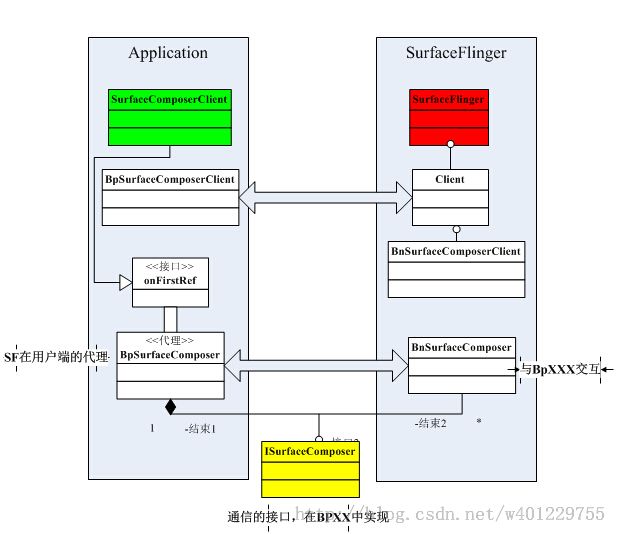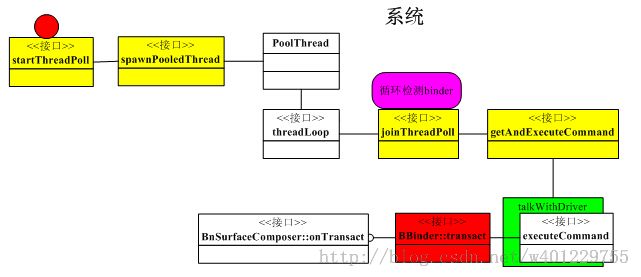Android4.4深入浅出之SurfaceFlinger与Client通信框架(一)
SurfaceFlinger框架是基于Binder进程间通信机制搭建的,SF作为一个服务进程,用户程序想要跟它通信必然要经过Binder机制。首先说一下,用户要跟SF通信,那么SF必须出现在ServiceManager中,因为SF也是一个服务,所有的服务都由ServiceManager来进行统一管理。在系统启动的过程中,SF就在ServiceManager中注册好了,注册好之后,SF在后台中监视一些surface的变化从而做出处理。
而启动之后,用户程序想操作一些跟surface有关的动作,就必须和SF进行交互。而这种交互是基于Binder进程间通信机制的。下面是一张图简单说明了SF的基本框架:
SurfaceComposerClient::SurfaceComposerClient()
: mStatus(NO_INIT), mComposer(Composer::getInstance())
{
}
void SurfaceComposerClient::onFirstRef() {
sp<ISurfaceComposer> sm(ComposerService::getComposerService());
if (sm != 0) {
sp<ISurfaceComposerClient> conn = sm->createConnection();
if (conn != 0) {
mClient = conn;
mStatus = NO_ERROR;
}
}
}
上面代码,第二行的作用是获得SurfaceFlinger这个服务,我们跟踪一下:
sp<ISurfaceComposer> ComposerService::getComposerService() {
ComposerService& instance = ComposerService::getInstance();
Mutex::Autolock _l(instance.mLock);
if (instance.mComposerService == NULL) {
ComposerService::getInstance().connectLocked();
assert(instance.mComposerService != NULL);
ALOGD("ComposerService reconnected");
}
return instance.mComposerService;
}
void ComposerService::connectLocked() {
const String16 name("SurfaceFlinger");
while (getService(name, &mComposerService) != NO_ERROR) {
usleep(250000);
}
assert(mComposerService != NULL); //省略了一些东西。。。
}
这里看到第三行getService(),第一个参数是“SurfaceFlinger”,第二个参数是mComposerService,记住它的类型的强引用的ISurfaceComposer,对就是这句得到了一个SurfaceFlinger服务的代理对象,看一下这个的函数的实体:
template<typename INTERFACE>
status_t getService(const String16& name, sp<INTERFACE>* outService)
{
const sp<IServiceManager> sm = defaultServiceManager();
if (sm != NULL) {
*outService = interface_cast<INTERFACE>(sm->getService(name));
if ((*outService) != NULL) return NO_ERROR;
}
return NAME_NOT_FOUND;
}
void SurfaceComposerClient::onFirstRef() {
sp<ISurfaceComposer> sm(ComposerService::getComposerService());
if (sm != 0) {
sp<ISurfaceComposerClient> conn = sm->createConnection();
if (conn != 0) {
mClient = conn;
mStatus = NO_ERROR;
}
}
}
这时候走到if,sm有值了,所以往下走,看名字可以得出这是客户端在请求连接到SurfaceFlinger服务。我们跟踪一下createConnection:
virtual sp<ISurfaceComposerClient> createConnection()
{
uint32_t n;
Parcel data, reply;
data.writeInterfaceToken(ISurfaceComposer::getInterfaceDescriptor());
remote()->transact(BnSurfaceComposer::CREATE_CONNECTION, data, &reply);
return interface_cast<ISurfaceComposerClient>(reply.readStrongBinder());
}
函数的大概意思是把一些连接信息写到数据包data里,然后通过transact这个函数传出去,remote()之前有研究过他是IBinder类的,这里重点看transact这个函数,他是IBinder类的成员函数故它的实现必定在BpBinder类里,我们跳到这个函数的实体:
status_t BpBinder::transact(
uint32_t code, const Parcel& data, Parcel* reply, uint32_t flags)
{
// Once a binder has died, it will never come back to life.
if (mAlive) {
status_t status = IPCThreadState::self()->transact(
mHandle, code, data, reply, flags);
if (status == DEAD_OBJECT) mAlive = 0;
return status;
}
return DEAD_OBJECT;
}
发现他又调用了transact这个函数,不同的是 是在IPCThreadState类中的 我们继续跟踪:
status_t IPCThreadState::transact(int32_t handle,
uint32_t code, const Parcel& data,
Parcel* reply, uint32_t flags)
{
status_t err = data.errorCheck();
flags |= TF_ACCEPT_FDS;
IF_LOG_TRANSACTIONS() {
TextOutput::Bundle _b(alog);
alog << "BC_TRANSACTION thr " << (void*)pthread_self() << " / hand "
<< handle << " / code " << TypeCode(code) << ": "
<< indent << data << dedent << endl;
}
if (err == NO_ERROR) {
LOG_ONEWAY(">>>> SEND from pid %d uid %d %s", getpid(), getuid(),
(flags & TF_ONE_WAY) == 0 ? "READ REPLY" : "ONE WAY");
err = writeTransactionData(BC_TRANSACTION, flags, handle, code, data, NULL);
}
if (err != NO_ERROR) {
if (reply) reply->setError(err);
return (mLastError = err);
}
if ((flags & TF_ONE_WAY) == 0) {
#if 0
if (code == 4) { // relayout
ALOGI(">>>>>> CALLING transaction 4");
} else {
ALOGI(">>>>>> CALLING transaction %d", code);
}
#endif
if (reply) {
err = waitForResponse(reply);
} else {
Parcel fakeReply;
err = waitForResponse(&fakeReply);
}
#if 0
if (code == 4) { // relayout
ALOGI("<<<<<< RETURNING transaction 4");
} else {
ALOGI("<<<<<< RETURNING transaction %d", code);
}
#endif
IF_LOG_TRANSACTIONS() {
TextOutput::Bundle _b(alog);
alog << "BR_REPLY thr " << (void*)pthread_self() << " / hand "
<< handle << ": ";
if (reply) alog << indent << *reply << dedent << endl;
else alog << "(none requested)" << endl;
}
} else {
err = waitForResponse(NULL, NULL);
}
return err;
}
这里已经扯到Binder机制的基本原理了,简单说就是客户端的SF代理通过BpBinder跟/dev/binder设备进行交互,向binder里写东西,函数err = writeTransactionData(BC_TRANSACTION, flags, handle, code, data, NULL);就是实现了这个功能,写完后他又等待服务端(SurfaceFlinger)那端的回应,err = waitForResponse(reply);当然服务端那边同样有人跟他进行交互。到这里,如果服务端收到消息并且返回了一个消息给客户端,这说明客户端请求连接成功。
请求成功后conn就不为0了,回到onFirstRef,成功后把coon赋给mClient。
既然客户端有请求了,那么服务端肯定有东西会去留意这个消息,回到更以前,做出向服务端请求连接这件事其实是SurfaceFlinger在客户端这边的代理BpSurfaceComposer完成的,那么之前说过,与之对应的就是BnSurfaceComposer。我们看一下他类的定义:
class BnSurfaceComposer: public BnInterface<ISurfaceComposer> {
public:
enum {
// Note: BOOT_FINISHED must remain this value, it is called from
// Java by ActivityManagerService.
BOOT_FINISHED = IBinder::FIRST_CALL_TRANSACTION,
CREATE_CONNECTION,
CREATE_GRAPHIC_BUFFER_ALLOC,
CREATE_DISPLAY_EVENT_CONNECTION,
CREATE_DISPLAY,
DESTROY_DISPLAY,
GET_BUILT_IN_DISPLAY,
SET_TRANSACTION_STATE,
AUTHENTICATE_SURFACE,
BLANK,
UNBLANK,
GET_DISPLAY_INFO,
CONNECT_DISPLAY,
CAPTURE_SCREEN,
};
virtual status_t onTransact(uint32_t code, const Parcel& data,
Parcel* reply, uint32_t flags = 0);
}
发现他没有构造函数只有一个成员函数 onTransact。跟踪一下:
status_t BnSurfaceComposer::onTransact(
uint32_t code, const Parcel& data, Parcel* reply, uint32_t flags)
{
switch(code) {
case CREATE_CONNECTION: {
CHECK_INTERFACE(ISurfaceComposer, data, reply);
sp<IBinder> b = createConnection()->asBinder();
reply->writeStrongBinder(b);
return NO_ERROR;
}
case CREATE_GRAPHIC_BUFFER_ALLOC: {
CHECK_INTERFACE(ISurfaceComposer, data, reply);
sp<IBinder> b = createGraphicBufferAlloc()->asBinder();
reply->writeStrongBinder(b);
return NO_ERROR;
}
case SET_TRANSACTION_STATE: {
CHECK_INTERFACE(ISurfaceComposer, data, reply);
size_t count = data.readInt32();
ComposerState s;
Vector<ComposerState> state;
state.setCapacity(count);
for (size_t i=0 ; i<count ; i++) {
s.read(data);
state.add(s);
}
count = data.readInt32();
DisplayState d;
Vector<DisplayState> displays;
displays.setCapacity(count);
for (size_t i=0 ; i<count ; i++) {
d.read(data);
displays.add(d);
}
uint32_t flags = data.readInt32();
setTransactionState(state, displays, flags);
return NO_ERROR;
}
case BOOT_FINISHED: {
CHECK_INTERFACE(ISurfaceComposer, data, reply);
bootFinished();
return NO_ERROR;
}
case CAPTURE_SCREEN: {
CHECK_INTERFACE(ISurfaceComposer, data, reply);
sp<IBinder> display = data.readStrongBinder();
sp<IGraphicBufferProducer> producer =
interface_cast<IGraphicBufferProducer>(data.readStrongBinder());
uint32_t reqWidth = data.readInt32();
uint32_t reqHeight = data.readInt32();
uint32_t minLayerZ = data.readInt32();
uint32_t maxLayerZ = data.readInt32();
status_t res = captureScreen(display, producer,
reqWidth, reqHeight, minLayerZ, maxLayerZ);
reply->writeInt32(res);
return NO_ERROR;
}
case AUTHENTICATE_SURFACE: {
CHECK_INTERFACE(ISurfaceComposer, data, reply);
sp<IGraphicBufferProducer> bufferProducer =
interface_cast<IGraphicBufferProducer>(data.readStrongBinder());
int32_t result = authenticateSurfaceTexture(bufferProducer) ? 1 : 0;
reply->writeInt32(result);
return NO_ERROR;
}
case CREATE_DISPLAY_EVENT_CONNECTION: {
CHECK_INTERFACE(ISurfaceComposer, data, reply);
sp<IDisplayEventConnection> connection(createDisplayEventConnection());
reply->writeStrongBinder(connection->asBinder());
return NO_ERROR;
}
case CREATE_DISPLAY: {
CHECK_INTERFACE(ISurfaceComposer, data, reply);
String8 displayName = data.readString8();
bool secure = bool(data.readInt32());
sp<IBinder> display(createDisplay(displayName, secure));
reply->writeStrongBinder(display);
return NO_ERROR;
}
case DESTROY_DISPLAY: {
CHECK_INTERFACE(ISurfaceComposer, data, reply);
sp<IBinder> display = data.readStrongBinder();
destroyDisplay(display);
return NO_ERROR;
}
case GET_BUILT_IN_DISPLAY: {
CHECK_INTERFACE(ISurfaceComposer, data, reply);
int32_t id = data.readInt32();
sp<IBinder> display(getBuiltInDisplay(id));
reply->writeStrongBinder(display);
return NO_ERROR;
}
case BLANK: {
CHECK_INTERFACE(ISurfaceComposer, data, reply);
sp<IBinder> display = data.readStrongBinder();
blank(display);
return NO_ERROR;
}
case UNBLANK: {
CHECK_INTERFACE(ISurfaceComposer, data, reply);
sp<IBinder> display = data.readStrongBinder();
unblank(display);
return NO_ERROR;
}
case GET_DISPLAY_INFO: {
CHECK_INTERFACE(ISurfaceComposer, data, reply);
DisplayInfo info;
sp<IBinder> display = data.readStrongBinder();
status_t result = getDisplayInfo(display, &info);
memcpy(reply->writeInplace(sizeof(DisplayInfo)), &info, sizeof(DisplayInfo));
reply->writeInt32(result);
return NO_ERROR;
}
default: {
return BBinder::onTransact(code, data, reply, flags);
}
}
// should be unreachable
return NO_ERROR;
}
代码虽然有点长,但是整体框架就是一个swith语句,看到第一个分支,马上就能看出来这是一个对请求连接信号的处理,这里大概能知道这个onTransact的功能就是判断收到的消息即参数code是哪种类型从而做出相应的处理。在server测,一开始创建SF服务的时候,在线城池创建的时候就已经开启线程去监听binder设备了我们来跟踪下:
从最开始SF服务启动的源文件开始:
int main(int argc, char** argv) {
// When SF is launched in its own process, limit the number of
// binder threads to 4.
ProcessState::self()->setThreadPoolMaxThreadCount(4);
// start the thread pool
sp<ProcessState> ps(ProcessState::self());
ps->startThreadPool();
是一个片段,最后一句就是开始线程池。跟踪其代码:
void ProcessState::startThreadPool()
{
AutoMutex _l(mLock);
if (!mThreadPoolStarted) {
mThreadPoolStarted = true;
spawnPooledThread(true);
}
}
核心也在最后一句,
void ProcessState::spawnPooledThread(bool isMain)
{
if (mThreadPoolStarted) {
String8 name = makeBinderThreadName();
ALOGV("Spawning new pooled thread, name=%s\n", name.string());
sp<Thread> t = new PoolThread(isMain);
t->run(name.string());
}
}
到这里,可以看到实质的线程创建和开始运行。接下来我用一张图来表示他的函数调用的走向:
这里一旦检测到有连接请求消息就会跳到executeCommand的switch分支BR_TRANSACTION,去执行BBinder的transact,transact函数会调用onTransact函数,这个onTransact由其子类实现,在这里由BnSurfaceComposer完成,即调用的是BnSurfaceComposer::onTransact(),函数的具体内容在上面已贴出,就是处理不同的请求。
到此为止,客户端已经与SF进行连接,也就是交手过了,那么自然连接了,一定要做些事情比如客户端请求渲染一个surface,或者等等其他的。接下去的工作就是SurfaceFlinger的事,对客户端不同的请求而进行不同的处理,这才是SF核心工作所在。当然所有的通信机制都是基于binder机制,而求也有负责这个方面的客户端这边的binder代理BpSurfaceComposerClient和服务端这边的本地对象 BnSurfaceComposerClient,而这里有点不一样的是BnSurfaceComposerClient派生出Client所以事情都交与Client做了。

